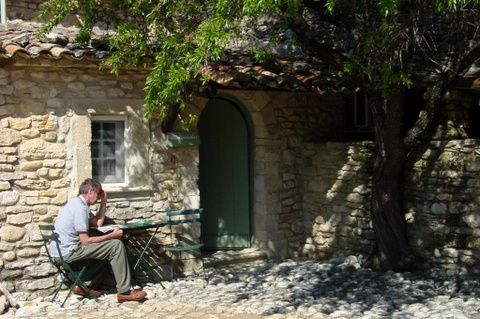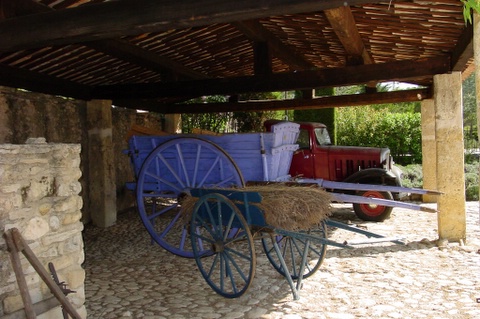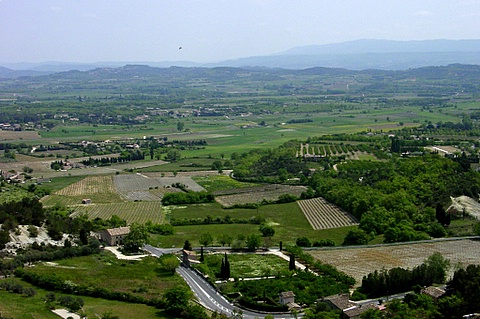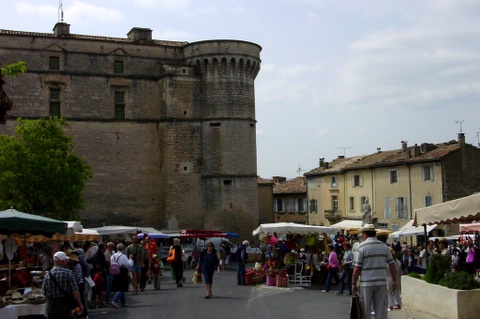
Gordes: Our room
under the almond tree

The view from our front door

Luberon countryside
|
|
 The view from our front door |
|
Provence (April 28-May 3): Our hotel for the next six days was La Ferme de la Huppe outside Gordes. The buildings are the original stone barns from an old sheep farm, and the grounds, rooms and restaurant are decorated with antique tools and farm implements. It reminded me of the landscaping on my family farm, except with paint.
The hotel restaurant has a renowned Dutch chef and a pricey menu -- dinner was 50 euros each, not including wine and water. Thanks to the Avignon city planners, we arrived late, so we ate there the first night. There was only one main course offered: chevre au [something]. That was a French word I was sure about (it's goat), so I asked for a substitution and was served fish. Ever the adventurer, Mike went for the goat. His verdict: tasty, interesting sauce, a little tough.
|
|
|
The next day, we drove to Arles for another walk through Roman history. The city has a 2000-year-old amphitheatre, theater, church and baths. We spent part of the afternoon walking through Les Alyscamps, an ancient Roman necropolis with an old chapel and hundreds of now-empty crypts.
Van Gogh is also a big deal in Arles. Every place he ever painted, drank or severed a body part has a plaque of some sort. The homage to him is a bit ironic, as the Arlesians circulated a petition to kick him out of town just a year after he arrived.
|
|
|
|
Later, we drove, then walked up (extra emphasis on that word) to Les Baux, a tiny town on an 800-foot-high rock. All the architecture is from the 16th and 17th centuries, and just about every building is designated an historical monument.
At the summit of the village is Les Citadelle des Baux, also called the "Dead City", an outdoor museum with a ruined castle complex carved from the rock. The panoramas from the castle and edge of the plateau are stunning -- miles and miles of vineyards and olive groves, framed by the Alpilles mountains in the distance.
We spent almost three hours wandering the 17-acre site and braving an incredibly fierce wind. The wind, which blows here from November to April, even has a name -- The Mistral -- and it's blamed for everything from insomnia to migraines to murders. I came home with gravel in my teeth, but the locals told me this had been the mildest of Mistral gales. This weather phenomenon must be about the only downside of living in Provence.
|
|
|
|
The next day was Sunday, which is market day in nearby Isle sur la Sorgue. It's the biggest market in the region, and we had to be aggressive to create a parking spot. The French leave their cars anywhere they like, and after a few weeks here, we had learned to do the same.
We browsed the antique stands, bought pottery and flowers, and tried free samples of cheeses, sausages, marinated olives and tampenades. The atmosphere was enhanced by several street performers. The oddest was a group of American Indians playing flutes and selling CDs.
After relaxing by the river that runs through the town, we headed back to the car (still in its wedge of an illegal space, but I knew it would be). We drove some pretty backroads to Fontaine la Vaucluse, famous for a spring that flows from a 750-foot-high cliff to create the River Sorgue. It's said to be the most powerful water source in France, and there were about 5000 other tourists who were determined to see it that day. Even with our loose standards, we couldn't find a parking space, so we returned to the hotel and spent the afternoon by the pool.
A few other hotel guests were at the pool trying to get up the nerve to put their toes into the icy water. Mike borrowed swim trunks from the chef and wowed all of us by jumping in, doing several laps, and emerging with skin not quite as blue as the water.
|
|
|
The next morning we decided to give Fontaine la Vaucluse another try. Parking was easier today (the weekend tourist buses were gone), but there was still quite a crowd trekking up the rocky trail to the fountain spring. When we got to the top, we were two of about 100 people who were all muttering the same thing: "I trudged up here for this?" The "gushing river" was an emerald-green pool of absolutely still water. We had to walk about a quarter mile downstream before we saw any water moving all.
|
|
|
|
We thought we could stand a little more excitement, so we drove to Roussillon, a hill town atop one of the world's biggest ochre deposits. Everything here is bathed in a warm, orangey-red -- the cliffs, the houses, the roofs -- and there's something gorgeous around every corner. The town is mobbed with tourists in the summer, but still manages to look authentic and unspoiled. We took a long walk around the squares and narrow streets, then hiked to the top of the village for a gorgeous view of the Luberon countryside.
We had skipped lunch and by 5:30, we were ready for dinner, but no cafe or restaurant in Roussillon -- or anywhere else in France -- serves food at that hour. There must be a French law that forbids the sale of anything but overpriced wine and coffee between 2:00 and 7:00 pm. We bought a bottle of wine in Roussillon, then drove to Gordes and waited until 7:00 to get a carryout pizza. We dined on the rock terrace outside our room and watched the night fall over the Luberon.
|
|

Gordes: Market day in the town square |
|
The next day was Tuesday, which was market day in Gordes, where we bought cheese, sausage, strawberries, olives and a crusty baguette for a picnic lunch. We drove over hilly roads to Notre-Dame de Senanque, a 12th-century abbey in a remote valley north of Gordes. It's surrounded by acres of lavender, but it wasn't yet blooming, so we could only imagine how beautiful that scene would be a month later.
|
|
|
We visited some other nearby villages the afternoon, including Joucas and Goult. Neither has a single tourist attraction, but they're both lovely. Joucas is a perched town with steep streets and just one business -- a sculptor whose work is displayed in little courtyards around the town.
After confirming that chevre had not reappeared on the menu, we opted for another 50-euro dinner back at our hotel. Tonight was porcelet de [something], a trio of tiny pork loins in secret sauce, with appetizer, salad and dessert. Everything was a bit unusual and very delicious.
Back in our room, we made a futile attempt to find something watchable on TV. At just about every hotel, the only choices were French news, a French talk-show channel, a station that showed nothing but a bad French version of "American Idol", and a BBC news station obsessed with soccer. Tonight, we happened to catch the news that the dollar was now trading at $1.26 per euro, up from $1.18 at the beginning of our trip. Oh, well ... when you're already spending $65 for a pork-chop dinner, another 8 cents per euro doesn't seem like that big a deal.
|
|
|
On Wednesday, we got a late start for a trip down to Cassis on the Mediterranean. It was a long drive, with beautiful scenery on the non-autoroute roads. The country highways are lined with towering chestnut trees, planted so near the road that you feel like you're driving through a tunnel.
We has plNNWS to take a boat trip to see the calanques, which are fjord-like inlets framed by tall white cliffs. By the time we got to Cassis, the winds had picked up and the boats had cancelled all their remaining excursions. It was a warm, sunny day, and we spent the afternoon hanging around cafes, walking along the beach and -- I'm sure I speak for both of us on this one -- not staring at the topless sunbathers.
On the way back, we stopped in Aix-en-Provence, which was once the capital of Provence. Today, it's a trendy city known for its art schools, fountains and high-priced shopping. We couldn't find even an illegal parking space, so we toured the city center by car. We made several trips up and down the "main drag" called Cours Mirabeau -- a tree-lined, fountain-studded boulevard of cafes, galleries, designer shops and old mansions. Back at our hotel, we had another al fresco dinner with the leftovers from our Gordes market trip.
|
|
|
|
Thursday was our last day in Provence. I had mellowed in my grudge against Avignon, so we went back into the city center. The popes were headquartered here in the 1300s, and the town's main attraction is the massive popes' palace (Le Palais des Papes). We passed on the tour, as I had read that the old popes took all the art and furniture with them when they relocated to Rome, so it was nothing but empty rooms.
The rest of the town is lovely. We wandered the streets inside the fortified walls and strolled the Place de l'Horologue, a long square with terrace cafes. We climbed up to the park above the palace, walked along the Rhone and saw the famous Pont d'Avignon -- a partial bridge named in the old children's song ("Sur le pont d'Avignon, L'on y danse ..."). Most of the bridge was destroyed by floods in the 1600s, but the rest was saved because of its divine origin. The story is that angels told St. Benezet, a local shepherd boy, to build the bridge, and he's buried in one of the surviving piers.
Late in the afternoon, we headed north to our airport hotel in Lyon. Our last view of Provence was the triumphal Roman arch at Orange, which serves as an official entrance into the region. We had a nice dinner on the outdoor patio at our Lyon hotel, the Campanile, and packed for the trip home tomorrow morning.
Lyon (May 5): We gassed up the car, spent the last of our euros and returned the car with no problems. Today is our anniversary, and we're spending it being scanned and frisked by creepy airport security guards. We had to fly through Heathrow again, where it takes a full 90 minutes just to change terminals. We were stopped at five different checkpoints requiring boarding passes, passports, various body scans and blood donations.
In the there's-no-place-like-home department: There were some things I was really missing -- our kitty, flat land, real diet Coke, decent TV, "normal" computer keyboards, Charmin, toilets that flush properly. Say what you will about America's technological failings when it comes to cars and electronics. There is still no country in the world that can compete with our plumbing.
Even $3.00 gasoline was a welcome sight back in the U.S., as gas was more than $5 a gallon in France. Our diesel car was getting around 45 mpg, though, so it didn't hurt too much. The car rental fee was the biggest bargain of all -- $324 for 18 days.
On driving: Driving was not difficult in France, but I'd really like to know what they were smoking when they came up with the naming scheme for their roads. The rural areas are a confusing jumble of D, N and A roads that are about as easy to understand as the double helix. The letters and numbers change for no reason ... and before you know it, the straight D road you thought you were on has dumped you back in the middle of Avignon.
If you want a speedier, more direct route, you pay dearly. The tolls are about $10 an hour on the French autoroutes. We grew very tired of seeing the words peage (on tollways) and payant (at parking lots), which translate to "open your wallet".
Food and drink: The wine everywhere was good and fairly inexpensive. Food is not a bargain, and although we had some outstanding meals, I was in danger of losing them when I saw the bills. Most French menus feature three- or four-course dinners for a set price, and the pricier the restaurant, the more limited the choices. I don't consider myself a picky eater, but there were a few places where there was absolutely nothing I could (would) eat. The Provencal restaurants are especially fond of serving roadkill (rabbit, boar, other wild things I didn't bother to translate). Their other favorites are duck, veal, lamb and organ meats, all on my I'd-rather-starve list. Okay, so maybe I am a picky eater, but would you have eaten -- or even looked at -- tete de veau ?
The social divide: I've always thought Americans had a generally poor work ethic, but we're sweatshop laborers compared to the French. They have a government-mandated 35-hour work week, and they seem to spend a lot of that time eating. Commerce comes to a daily standstill from noon to 2:00, when every shop and office closes its doors for lunch. And since lunch usually includes wine, not all that much gets accomplished in the afternoons.
If you believe the warnings in the tourist areas, France is a nation of thieves. Everywhere we went, there were reminders to put your parcels in the trunk, lock your car, guard your wallet, hug your purse. The only shady-looking people we saw were the security staff at the airports, and few of them were French.
We found no evidence to support the stereotype of the French as snooty, American-hating snobs. The people we met were warm and friendly, especially in Normandy, where the locals have not forgotten U.S. heroics. No one rolled their eyes at my French (not while I was looking, anyway), although I'm sure I amused a few waiters.
On the plus side: There can't be any place in the world that has better coffee, bread and pastries. The French history is fascinating and everything everywhere was drop-dead gorgeous -- even that bogus fountain in Fontaine de Vaucluse.
It's refreshing that the French, unlike U.S. developers, respect their history and protect the vestiges of the past. They wouldn't think of tearing down a stone building to put up a strip mall, or obliterating their historic monuments with OSHA guard rails and warning signs. They drive small cars with manual transmissions, and they can't understand why Americans buy tanks, then whine about gasoline costs (Moi aussi!). They don't obsess about drinking, smoking, zoning laws, parking regulations or dogs, although it wouldn't hurt if they'd become a little more obsessive about pooper scoopers. Interesting trivia: Every year, 600 people suffer broken limbs from slipping on French dog poop.
The pluses win. We're already talking about going back, as soon as our budget and the euro will allow.
Back to Page 2 -- The Dordogne & Languedoc-Roussillon
Back to Page 1 -- Normandy & The Loire Valley